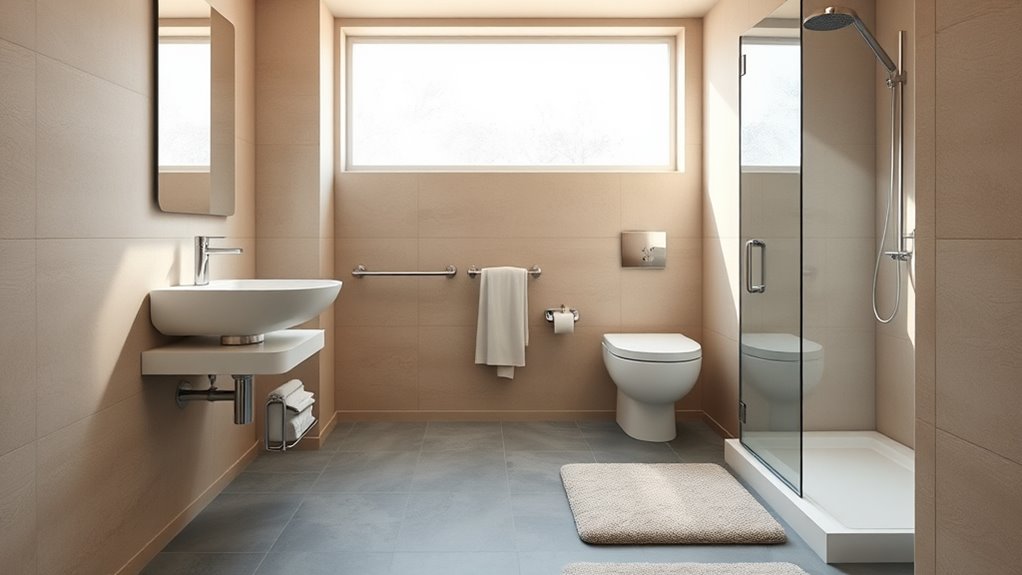Designing a bathroom that prioritizes safety and comfort involves choosing slip-resistant flooring, installing grab bars, and ensuring at least 36 inches of space for easy movement. Use proper lighting to improve visibility and select user-friendly fixtures with easy controls. Incorporate accessible features like walk-in showers, built-in niches, and supportive handrails to reduce fall risks. Proper storage keeps clutter at bay, creating a safer environment. Discover more tips to make your bathroom both secure and inviting.
Key Takeaways
- Incorporate grab bars, handrails, and support features securely anchored for enhanced stability and fall prevention.
- Use slip-resistant flooring materials like textured tiles or rubber with high safety ratings in wet zones.
- Optimize lighting with layered, glare-free, and natural light sources to improve visibility and reduce fall risks.
- Install user-friendly fixtures with ergonomic controls, anti-scald technology, and digital alerts for safety and ease of use.
- Design with accessible layouts, adjustable storage, and clutter-free surfaces to promote ease of movement and reduce hazards.
Assessing Space and Identifying Safety Risks

To create a safe and functional bathroom, start by thoroughly evaluating the current layout to spot potential hazards. Check for slippery floors that could cause falls and ensure water isn’t pooling on surfaces. Digital literacy programs can also help seniors understand how to safely operate and maintain new safety features. Measure the space to confirm there’s at least 36 inches of clearance in key areas, allowing for safe movement. Assess the lighting to ensure it’s bright enough for visibility at all times, reducing accident risks. Inspect fixtures and thresholds; high or uneven thresholds can be tripping hazards. Consider mobility challenges or physical limitations of users, which might require installing grab bars or other safety features. Conducting a space optimization review early in the planning process helps you design a bathroom that prioritizes bathroom safety, minimizes risks, and creates a comfortable, accessible space for everyone. Incorporating professional assessments can further identify unseen hazards and recommend tailored modifications to enhance safety. Additionally, understanding how to identify potential hazards from water pooling or slipperiness can significantly improve overall safety. Leveraging automation in safety monitoring systems can also provide real-time alerts for water leaks or dangerous conditions, further safeguarding users.
Choosing Slip-Resistant Flooring and Surface Materials
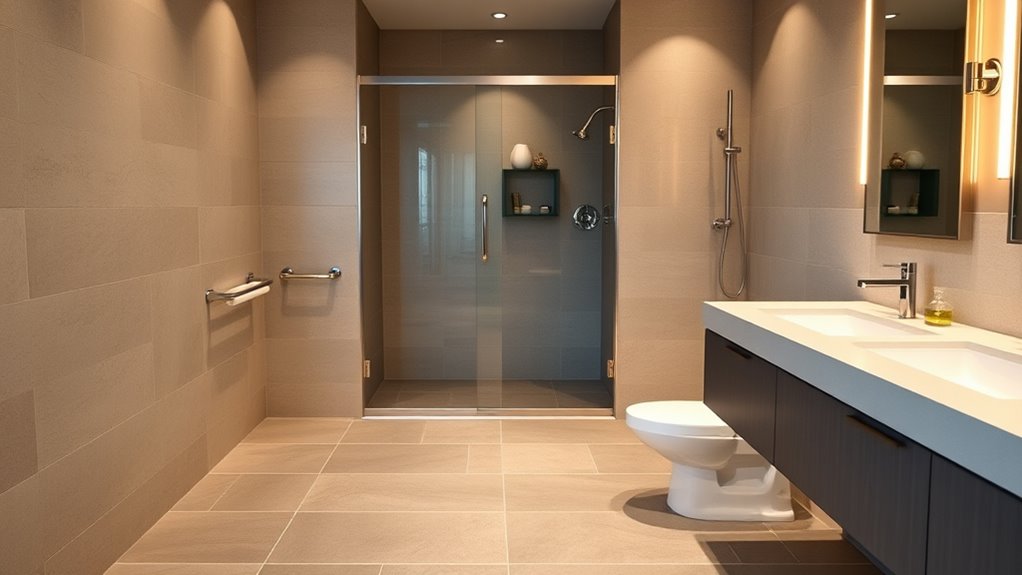
Choosing the slip-resistant flooring is vital for safety, especially in wet areas. You should consider flooring materials with high slip resistance ratings, like textured tiles or rubber surfaces. These options help prevent falls and keep your bathroom safer over time. Additionally, selecting surfaces that are easy to clean and maintain can help prevent mold and mildew buildup, further enhancing safety and hygiene. Incorporating Kia Tuning techniques into your renovation can also inspire innovative safety features and stylish surface options, ensuring both functionality and aesthetic appeal in your bathroom. Understanding the importance of contrast ratio in home projectors can also influence your overall design choices, promoting a safe and visually appealing environment. Emphasizing vibrational energy in your design choices can promote a more relaxing and positive environment, contributing to overall well-being.
Slip Resistance Ratings
Selecting the right slip-resistant flooring and surface materials is crucial for bathroom safety. Look for textured tiles with a dynamic coefficient of friction of 0.42 or higher to guarantee good traction. Anti-slip surfaces rated R9 to R13 are ideal for wet areas like showers and near bathtubs, providing reliable slip resistance. Incorporating HEPA filtration and other safety-enhancing features can further improve overall bathroom air quality and reduce airborne hazards. Larger slip-resistant tiles with fewer grout lines are easier to clean and maintain, while also offering consistent traction. Incorporating textured surfaces on flooring and mats helps prevent slips, especially in high-moisture zones. Always check safety ratings when choosing flooring or surface materials, as they directly influence bathroom safety. Evaluating digital safety features such as slip sensors or alarms can add an extra layer of protection in modern bathrooms. Incorporating maintenance considerations into your selection ensures the longevity and effectiveness of slip-resistant features. Proper cleaning techniques are essential for maintaining slip resistance over time and preventing the buildup of slippery residues. Additionally, selecting surfaces compatible with filtering systems can help reduce airborne contaminants and improve overall safety. By prioritizing slip resistance ratings, you reduce fall risks and create a safer, more comfortable bathroom environment for everyone.
Material and Texture Options
When it comes to slip-resistant flooring and surface materials, opting for textured surfaces like porcelain tiles, rubber, and vinyl with high R-values (R9 to R13) can markedly enhance bathroom safety. These slip-resistant flooring options feature surface textures that provide better grip, reducing the risk of falls.
Larger tiles with minimal grout lines are easier to clean and help prevent water buildup, which can cause slipping. Non-porous materials, such as solid surface countertops and glass shower enclosures, also contribute to safety by resisting water absorption and maintaining low-slip textures.
Additionally, anti-slip coatings can be applied to existing surfaces, offering extra slip protection without compromising style. Incorporating varied surface textures and finishes improves visibility and tactile feedback, especially for those with mobility challenges or diminished eyesight. Using aesthetic wall organization systems to keep bathroom surfaces dry and clutter-free further enhances overall safety and accessibility.
Incorporating water-resistant materials designed specifically for wet environments can also help maintain long-term safety and durability of bathroom surfaces. Selecting surfaces with integrated slip resistance features can provide consistent grip and reduce hazards in wet conditions. Moreover, understanding the importance of surface texture diversity can help create a safer and more comfortable bathroom environment.
Furthermore, selecting materials with non-slip properties that meet safety standards ensures a consistent level of grip across different surfaces, contributing to a safer bathroom environment.
Installing Support Features Like Grab Bars and Handrails
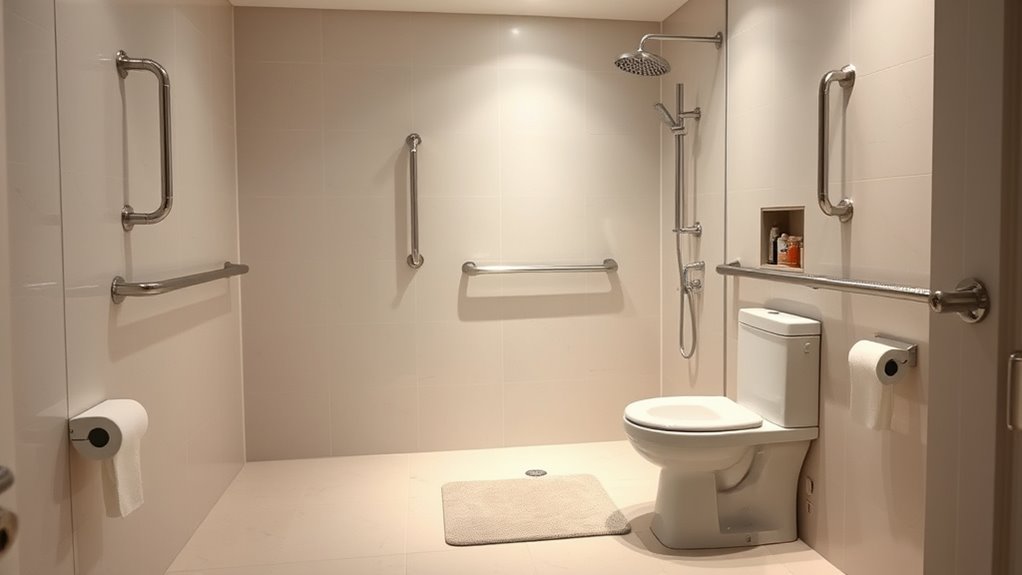
Installing support features like grab bars and handrails is essential for enhancing safety and stability in your bathroom. Proper installation ensures these support features effectively reduce fall risks.
To maximize bathroom safety, consider these steps:
- Secure grab bars into wall studs or use anchors rated for at least 250 pounds to ensure sturdy support.
- Place grab bars at 33-36 inches above the floor, following ergonomic guidelines for ideal grip.
- Choose a variety of styles—straight, angled, or fold-down—to match your aesthetic while maintaining safety.
- Incorporate quotes about guidance and support to reinforce the importance of safety and encouragement in caregiving and home modifications. Additionally, selecting water-resistant materials for support features can enhance durability and longevity. Using proper installation techniques ensures that these features perform reliably over time.
- When installing grab bars, ensure they are mounted securely into wall framing or studs to support substantial weight and prevent accidents.
Strategic placement and secure installation of these support features markedly improve stability, especially for seniors and those with mobility challenges. This proactive approach can decrease bathroom fall injuries by up to 60%.
Designing Accessible Shower and Tub Areas

Have you considered how a thoughtfully designed shower or tub can markedly improve safety and accessibility in your bathroom? Installing grab bars and non-slip surfaces is essential.
An accessible shower with a zero-threshold design eliminates tripping hazards and makes wheelchair access easier. Built-in benches and niches provide comfortable seating and storage, reducing the need to bend or reach. Additionally, industry trends indicate that innovative materials and designs are continually improving safety features in bathroom fixtures.
For those with mobility challenges, walk-in tubs with side doors and safety features like non-slip surfaces offer safer, more comfortable bathing options. Smart controls and digital features can prevent scalds and make operation easier.
Incorporating positive thinking principles into your planning process can help you approach these modifications with confidence and optimism, ensuring a successful redesign. These design choices create a safer, more accessible environment, ensuring that everyone can enjoy bathing with confidence and comfort. In addition, understanding the different types of pinball machines can inspire innovative design ideas that combine entertainment and safety features.
Optimizing Lighting for Visibility and Ambiance
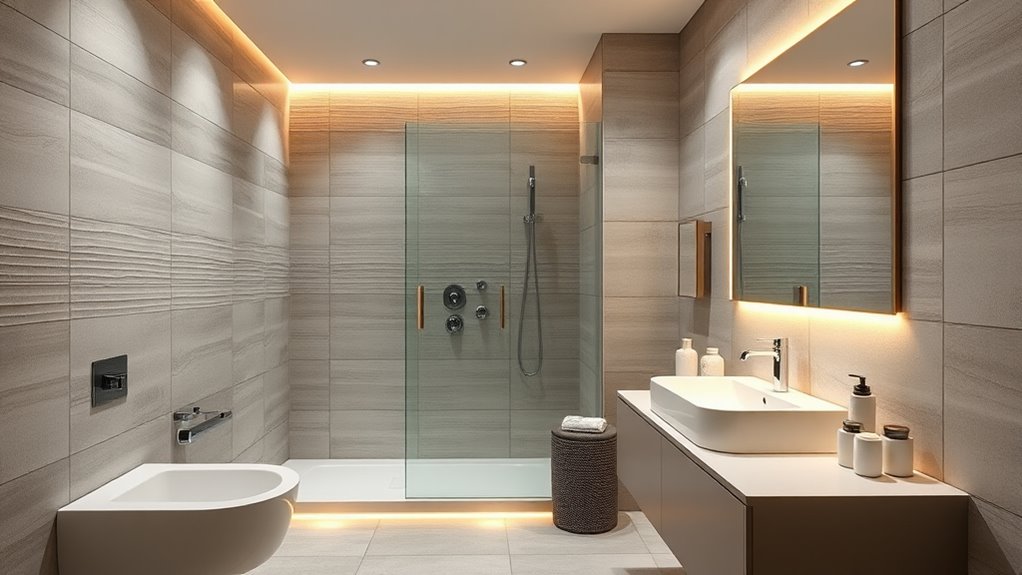
Optimizing lighting in your bathroom is essential for both safety and creating a welcoming atmosphere. Proper lighting enhances visibility, reducing fall risks and making daily routines safer.
Optimized bathroom lighting enhances safety, visibility, and a welcoming atmosphere for everyday comfort.
Focus on layered illumination with ambient, task, and accent lighting. To achieve this, consider:
- Installing bright, glare-free LED lights around mirrors and work areas to improve clarity and minimize shadows.
- Using dimmable fixtures and motion sensors for energy efficiency and convenient control, especially at night.
- Incorporating natural light through larger windows or skylights to boost wellbeing and reduce reliance on artificial lighting.
These strategies ensure your bathroom’s lighting supports safety, visibility, and ambiance, creating a space that’s both functional and inviting. Proper lighting makes a significant difference in your daily comfort and security.
Selecting User-Friendly Fixtures and Controls
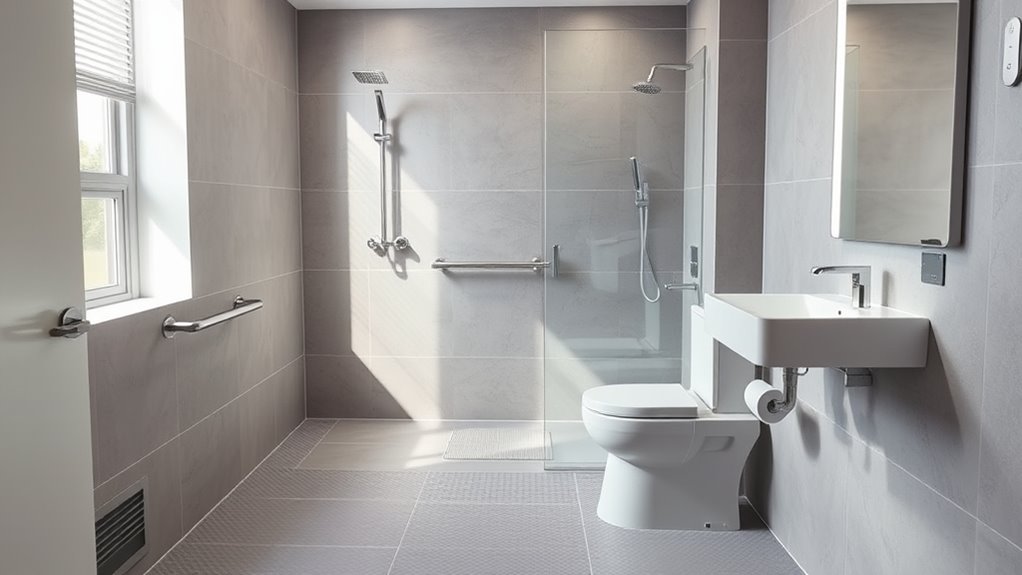
Choosing fixtures and controls that are user-friendly can substantially improve safety and convenience in your bathroom. Select safety fixtures like grab bars and accessible controls placed at reachable heights to accommodate all mobility levels.
Use fixtures with lever handles or touchless operation to reduce grip strength needs and lower slip risks. Install anti-scald valves and thermostatic controls to ensure safe temperature regulation, preventing burns from sudden changes.
Opt for low-profile, easy-to-locate controls with clear labels and contrasting colors to enhance visibility for users with diminished eyesight. Choose fixtures with ergonomic surfaces that are textured or large enough to operate easily even with wet hands or limited dexterity.
These thoughtful choices make your bathroom safer and more comfortable for everyone.
Incorporating Storage Solutions for Safety and Convenience
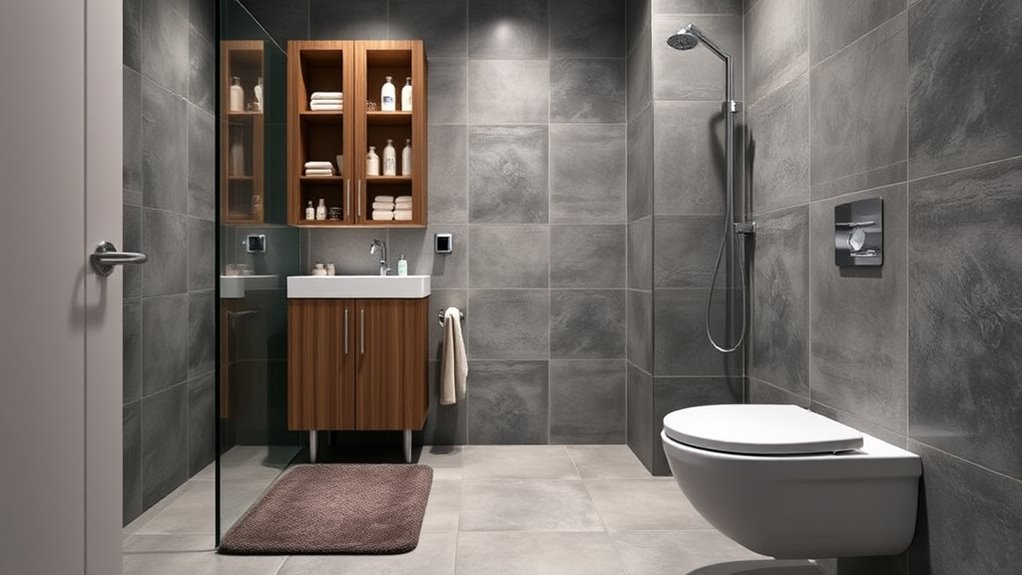
To keep your bathroom safe and convenient, choose storage solutions that are easy to access and keep surfaces clutter-free. Adjustable cabinets and built-in niches help accommodate different needs and prevent items from falling.
Well-designed storage reduces trip hazards and creates a tidy space for everyone.
Accessible Storage Options
Accessible storage options are essential for creating a bathroom that’s safe and convenient for everyone. By choosing the right solutions, you can enhance safety features and support mobility needs.
Consider these options:
- Use pull-out shelves, open shelving, or Lazy Susans to reduce bending and reaching, lowering fall risks.
- Install lower-height cabinets and vanity drawers, keeping essential items within easy reach.
- Incorporate clear labeling and contrasting colors on storage units to improve visibility and prevent accidents.
Wall-mounted or vertical storage maximizes space efficiency while keeping floors clear, reducing tripping hazards.
Modular and adjustable systems allow you to customize storage as needs evolve, making bathroom remodeling a straightforward process that prioritizes long-term safety and convenience.
Clutter-Free Surfaces
Keeping bathroom surfaces clutter-free is essential for safety and convenience. Incorporating smart storage solutions like built-in shelves, wall-mounted cabinets, and recessed niches helps keep surfaces clear, reducing tripping hazards.
Choose storage options that are easily reachable to minimize bending and reaching, which decreases fall risks—especially for seniors and those with mobility issues. Using anti-slip baskets and organizers prevents items from falling onto the floor, maintaining a tidy environment.
Proper storage placement, like keeping frequently used items at waist level, promotes organization and prevents clutter from accumulating on countertops and floors. Closed cabinetry with doors and drawers conceals toiletries and cleaning supplies, enhancing bathroom design while reducing visual clutter that could cause accidents.
Prioritizing clutter-free surfaces boosts both safety and comfort in your bathroom.
Collaborating With Professionals for Long-Term Safety
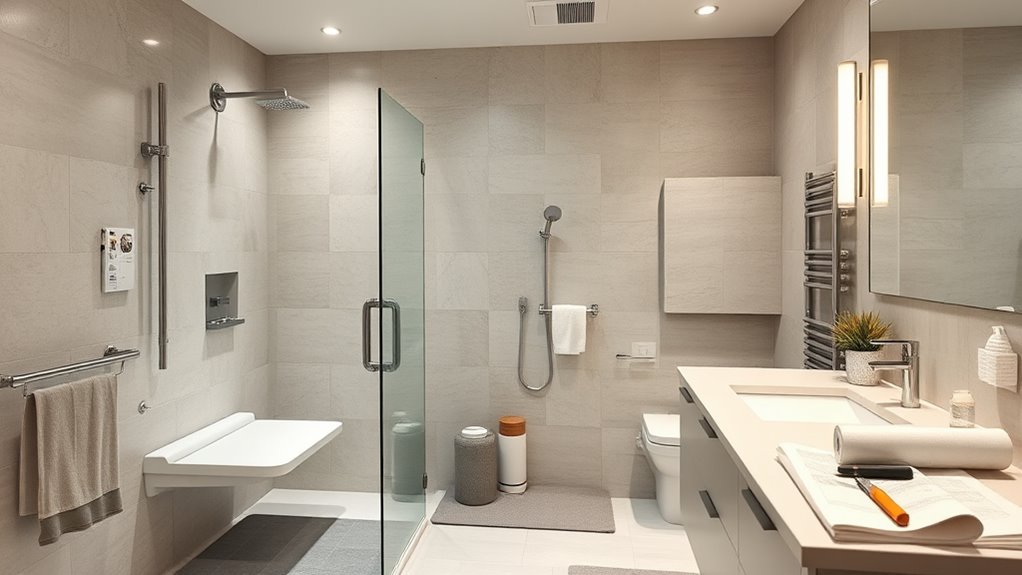
Collaborating with experienced professionals plays a crucial role in guaranteeing your bathroom remains safe and functional for the long term. They help you meet safety standards by integrating features like grab bars, slip-resistant flooring, and proper lighting tailored to your needs.
To maximize safety and accessibility, consider these steps:
- Work with professional installers to ensure safety features are correctly installed, reducing accident risks.
- Engage specialists for in-home consultations to identify hazards and develop customized solutions.
- Seek ongoing guidance from experts throughout the renovation process to maintain safety standards and future-proof your bathroom.
Partnering with qualified professionals guarantees that every aspect of your bathroom design aligns with safety standards, offering you peace of mind now and long-term safety for years to come.
Frequently Asked Questions
What Is an Adaptive Bathroom?
An adaptive bathroom is designed to meet your specific needs if you have mobility challenges or disabilities. It includes safety features like grab bars and slip-resistant floors, making it safer to move around.
You’ll find adjustable fixtures, such as height-friendly sinks and toilets, that help you maintain independence. Additionally, assistive tech like touchless faucets and voice controls make daily routines easier, ensuring your bathroom is both safe and comfortable.
What Is One Safety Hint for the Bathroom?
To boost bathroom safety, consider installing grab bars near your shower, tub, and toilet. These support features help prevent falls and provide stability, especially for those with mobility issues. Make sure they’re securely anchored and easy to grip.
Combining this with slip-resistant tiles and proper lighting creates a safer environment. Keep electrical outlets covered and away from wet areas to prevent shocks.
Separating wet and dry zones also minimizes water spills and hazards.
What Is Transitional Bathroom Design?
They say, “Old habits die hard,” but conversion bathroom design proves you can blend the best of both worlds. You create a space that combines traditional charm with modern flair, using neutral colors, classic fixtures, and sleek accents.
This style emphasizes functionality, seamlessly integrating safety features like grab bars and slip-resistant floors. It’s versatile, timeless, and easy to update—perfect if you want a bathroom that’s both stylish and safe.
What Is the Bathroom Trend in 2025?
In 2025, bathroom trends focus on smart technology, so you’ll find voice-activated fixtures and automated lighting making your space more convenient.
Barrier-free showers and walk-in tubs improve accessibility and aesthetics.
Eco-friendly fixtures like low-flow toilets and LED lighting help you save energy.
Natural materials and ample light promote wellness.
Customized storage keeps your bathroom clutter-free and safe, ensuring both comfort and modern style.
Conclusion
By prioritizing safety and comfort in your bathroom design, you set yourself up for peace of mind and daily convenience. Think of it as building a fortress where you can relax without worries. From slip-resistant floors to thoughtful support features, every detail matters. Don’t try to do it all alone—collaborate with professionals to guarantee your space is both safe and inviting. After all, a well-designed bathroom is the foundation of a comfortable home.
